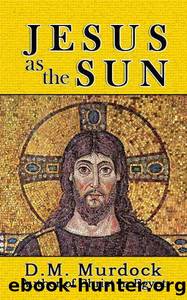Jesus as the Sun throughout History by Acharya S & D.M. Murdock

Author:Acharya S & D.M. Murdock [Murdock, D.M.]
Language: eng
Format: azw3, mobi
Publisher: Stellar House Publishing
Published: 2020-07-22T16:00:00+00:00
The Solar Logos
As also discussed beginning in antiquity and continuing for many centuries, another Platonic concept clearly adopted into Christianity was the Logos or Word of God, likewise developed by the Jewish writer Philo, before it was applied to Christ. The Logos, as both Plato and Philo express it, is solar in nature. 92 In this same regard, in his Exhortation to the Heathen (VI), Clement of Alexandria equates the Word with the “Sun of the soul.” 93 When Christ becomes the Logos, he too is thus solar in nature. Concerning the solar Logos, in Suns of God, I write:
Josephus affirms the Logos’s solar identification in his discussion of the menorah, or seven-branched candlestick, representing the sun in the middle surrounded by the moon and five planets, the central sun of which...was recognized by Philo as the Word of God. In Revelation/Apocalypse [1:13], Christ is depicted as the solar Logos in the middle of the “seven candlesticks or lamps,” i.e., the menorah. 94
The equation of Christ with the sun, which we have seen proved to be an ancient concept from the very beginning of Christianity, is therefore appropriate, once again, because of his role as the solar Logos.
As concerns the enduring identification of Christ with the sun, librarian to Pope Leo X (1475-1521), Cardinal Tommaso Inghirami (1470-1516) equated Jesus with Apollo: “We have speeches by Inghirami in which he refers to Jesus as Apollo, Mary as Minerva, Gabriel as Mercury.” 95 This statement is particularly interesting in light of the fact that in “The Pageant of Popes,” English clergyman and satirist John Bale (1495-1563) made Pope Leo X exclaim, “It is well known to all ages how profitable this fable of Christ has been to us,” 96 possibly an indication of true papal insight and sentiment in consideration of Inghirami’s speeches.
Concerning this ongoing solar scenario, also in the 16th century, Ignatius of Loyola (c. 1491-1556), founder of the Jesuits, experienced many “visions,” including those in which “he saw Christ as the sun.” 97
German Christian mystic Jakob Böhme (c. 1575-1624) likewise used Christ as the sun as one of his “great symbols.” 98 As stated by Dr. Linda A. Curcio-Nagy, a professor of History at the University of Nevada: “Seventeenth-century metaphors consistently posited the Virgin as the moon and Christ as the sun.” 99
Because the ideas were so prevalent among his congregation, the English puritan and theologian Richard Baxter (1615-1691) found it expedient to denounce the "heathenish ignorance" that Christ was the sun and the Church the moon. 100
In the 18th century, German scholar Paul Ernesti Jablonski/y (1693-1757), a professor of Theology at Frankfurt, likewise raised the issues of Yahweh, Jesus and the sun, in a multivolume study entitled, Pantheon Ægyptiacum . 101
Download
Jesus as the Sun throughout History by Acharya S & D.M. Murdock.mobi
This site does not store any files on its server. We only index and link to content provided by other sites. Please contact the content providers to delete copyright contents if any and email us, we'll remove relevant links or contents immediately.
The Gnostic Gospels by Pagels Elaine(2472)
Jesus by Paul Johnson(2310)
Devil, The by Almond Philip C(2282)
The Nativity by Geza Vermes(2180)
The Psychedelic Gospels: The Secret History of Hallucinogens in Christianity by Jerry B. Brown(2121)
Forensics by Val McDermid(2044)
Going Clear: Scientology, Hollywood, and the Prison of Belief by Lawrence Wright(1938)
Going Clear by Lawrence Wright(1923)
Barking to the Choir by Gregory Boyle(1786)
Old Testament History by John H. Sailhamer(1769)
Augustine: Conversions to Confessions by Robin Lane Fox(1736)
The Early Centuries - Byzantium 01 by John Julius Norwich(1701)
A History of the Franks by Gregory of Tours(1684)
A Prophet with Honor by William C. Martin(1682)
Dark Mysteries of the Vatican by H. Paul Jeffers(1675)
The Bible Doesn't Say That by Dr. Joel M. Hoffman(1652)
by Christianity & Islam(1594)
The First Crusade by Thomas Asbridge(1576)
The Amish by Steven M. Nolt(1531)
